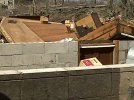CheeselandSkies
Member
One significant tornado event that intrigues me is the April 10, 2011 Merrill, WI tornado. Aside from being the strongest tornado in an early-season tornado outbreak where the peak tornado season is usually in the summer, the tornadoes occurred with patches of snow still on the ground.
Video taken as the tornado was forming that possibly shows patches of snow still on the ground in the background (though unfortunately it's very difficult to tell for sure):
NWS Green Bay page with information on all of the tornadoes including the Merrill EF3. In one of the pictures snow can be clearly seen; seeing a wedge tornado and snow on the ground in the same picture is interesting to say the least.
Wow, I had no idea there was any footage of that, least of all of its formation! Central and northern (and most of southern, but not as bad) Wisconsin is heavily forested and dangerous chase terrain (although probably not much different from Dixie Alley in that regard). I was living in Milwaukee at the time and remember being annoyed that the outbreak seemed to be skipping the southern part of the state and thus was out of my chase range. Some of the wording on the initial Day 2 outlook was very ominous, making it sound like we were staring at a nearly unprecedented regional outbreak of long-lived tornadic supercells (basically exactly what would happen to Dixie Alley 2 1/2 weeks later; or another Palm Sunday 1965). As it turned out it wasn't quite that bad, but still a very significant outbreak by Wisconsin standards especially for April. Of course, this was only six years after our state record-setting tornado outbreak happened on a slight risk day in mid-August.



































